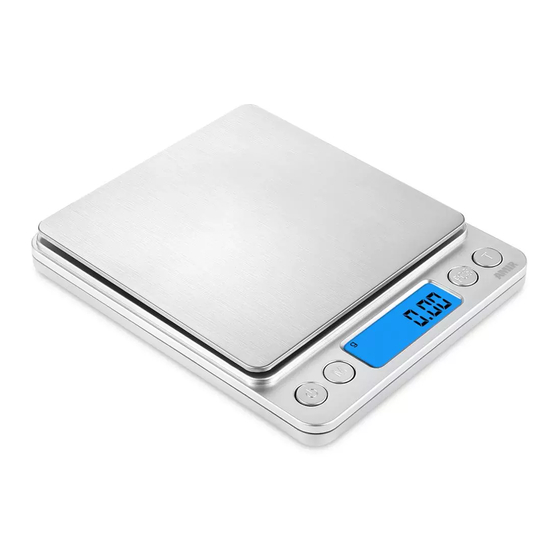
Table of Contents
Advertisement
Quick Links
Thank you for purchasing AMIR pocket kitchen scale. With normal care and proper
treatment, this scale will provide years of reliable service.
Maintenance and Care
1. Avoid exposure to extreme heat or cold. Also avoid any kind of moisture. Always
allow your scale to acclimate to normal room temperature before use.
2. Keep your scale in a clean and dry environment may have an adverse effect on
the accuracy and reliability of the scale.
3. Handle the scale with care. Gently apply all items to be weighed on the tray top.
Although this scale is designed to be quite durable, avoid rough treatment, as this
may permanently damage the internal parts. Always avoid shaking and dropping.
This is a precision instrument and should be handled with extreme care.
Specifications
● Model: KA8, Capacity: 500g, Accuracy: 0.01g
● Units: g, oz, ozt, dwt, ct, gn
● Key function: ON/OFF, UNIT(M), PCS, TARE(T)
● Display: LCD display with blue backlight
● Auto off: 0/60/120/180 seconds of inactivity
● Power: 2 AAA batteries
● Operation Temperature: 10 to 30 degree Centigrade
Operation
1. Place the scale on a leveled surface & press "ON/OFF" key to turn on the scale or
power it off.
2. Wait unit the LCD display shows zero, then press "M" button to choose the
weighing unit.
3. Place the item to be weighed on the surface and wait unit the reading is stable.
AMIR Pocket Kitchen Scale
Advertisement
Table of Contents

Summary of Contents for AMIR KA8
- Page 1 AMIR Pocket Kitchen Scale Thank you for purchasing AMIR pocket kitchen scale. With normal care and proper treatment, this scale will provide years of reliable service. Maintenance and Care 1. Avoid exposure to extreme heat or cold. Also avoid any kind of moisture. Always allow your scale to acclimate to normal room temperature before use.
- Page 2 Tare Function 1. Turn on the scale as described above. 2. Place the trays provided or other containers on the scale, then press “T” button on the platform and wait unit the LCD displays zero. 3. Scale can now be used for weighing. Add the “net-weight- item”. Counting Function 1.
- Page 3 1. “Lo”: Low voltage. Please replace the batteries. 2. “O-Ld”: Over load. Please remove item quickly to protect the scale. Package Includes: 1× Digital pocket scale 2× Platform cover 2× AAA batteries 1× User Manual...
Need help?
Do you have a question about the KA8 and is the answer not in the manual?
Questions and answers
my scale is weighing off how can I fix it this quarter should wegh 6.25 g
To fix the AMIR KA8 scale if it is weighing off and should weigh 6.25 g, follow these steps:
1. Place the Scale on a Level Surface: Ensure the scale is on a flat and stable surface.
2. Turn On the Scale: Press the “ON/OFF” button and wait for the display to show zero.
3. Tare the Scale (if using a container): Place the empty container on the scale, press the “T” button, and wait for the display to reset to zero.
4. Check the Unit: Press the “M” button to select the correct weighing unit (e.g., grams).
5. Use a Calibration Weight: If the scale continues to weigh inaccurately, it may need calibration. Although the manual does not specify a calibration procedure, typically this involves pressing a specific button sequence with a known weight (e.g., 100g, 200g). Refer to the full manual for calibration instructions.
6. Ensure Proper Conditions: Make sure the scale is within the operating temperature range of 10 to 30°C and avoid moisture or drafts.
7. Replace Batteries: If the display is dim or unstable, replace the 2 AAA batteries.
If these steps do not correct the issue, the scale may need professional calibration or replacement.
This answer is automatically generated